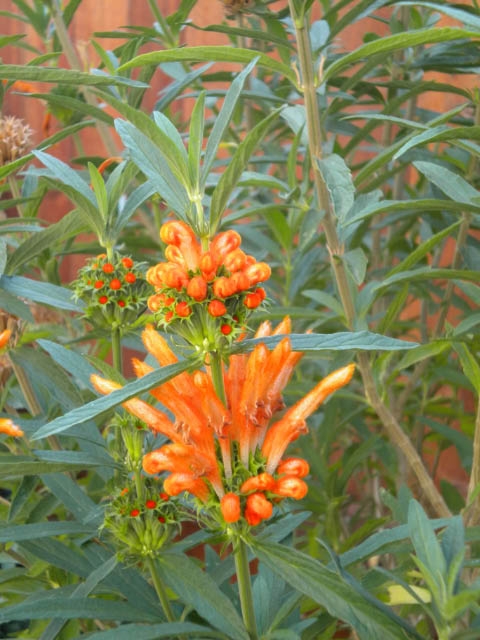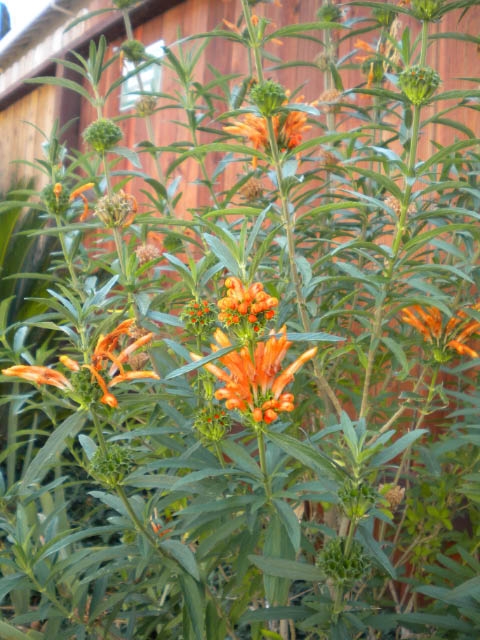Posts Tagged: Africa
Word of the Day: Nototribic
The black-tailed bumble bee wasn't flying very well. You wouldn't, either, if you were trying to fly with a backpack on your back. Except this...
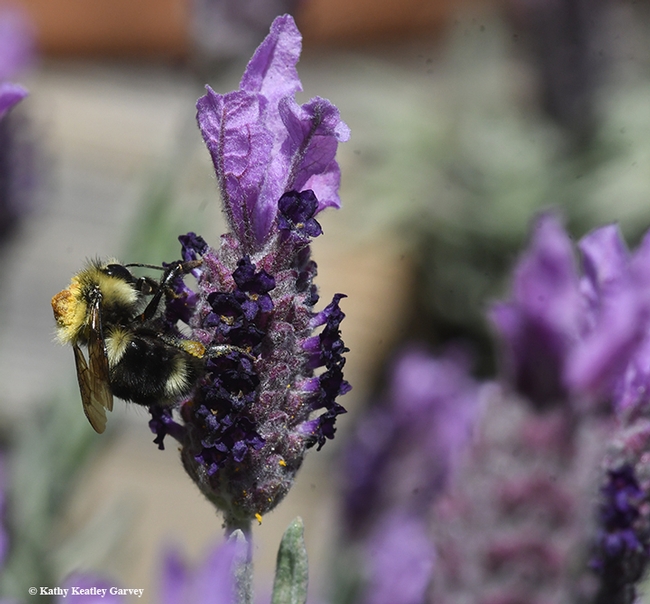
A black-tailed bumble bee, Bombus melanopygus with a thick load of resin on her thorax. She had just visited a nototribic flower. (Photo by Kathy Keatley Garvey)
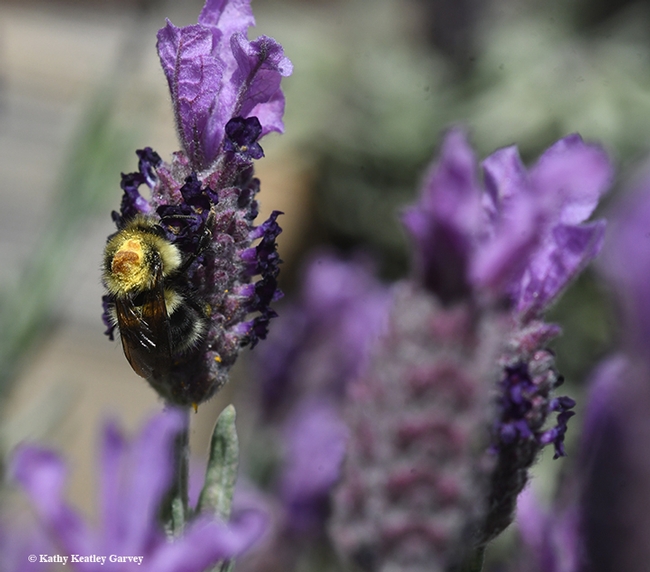
Dorsal view of the pollen hump on the back of the black-tailed bumble bee. (Photo by Kathy Keatle Garvey)
Gesundheit!
I have always been impressed with the drama of hot pokers, Kniphofia. However several things held me back from purchasing them. First I don't like buying plants whose names I can't pronounce and Kniphofia ( knee fof ee a ) has had me stymied for a long time. When I was Googling Kniphofia, one of the first categories that came up was pronunciation, so I don't think I am alone. To me the name sounds like a sneeze; I get this uncontrollable urge to say "Gesundheit " every time I hear someone say it.
Secondly, most of the plants I have admired have been very large, with mounds of foliage reaching three to four feet high and sometimes five to eight feet wide and that's not even counting the blooms. I have a small front yard and a small border area available so I thought I would have to forgo a hot poker. (Note, in researching this article I found the most charming turn of phrase on the Digging Dog Nurserysite. Instead of calling a garden small, they called it space-thrifty.)
But then at Annie's Annuals I found Kniphofia 'Wol's Red Seedling'. This hybrid was carefully bred in England. Kniphofias are originally from South Africa, but were brought to England in the 1800s and are very popular there. This little darling has leaves that top out at a foot and flower spikes to two feet. It has a brilliant red color that is described by several sites as the reddest of all the pokers. They mentioned it could even be grown in a container. You guessed it, I brought one home.
I tucked it in the front yard in the border by the faux dry stream bed, amongst the 'Stella d'Oro' dwarf day-lilies and the lavender. The first summer it had three small blooms and I was a little discouraged. This year I have six blooms already, and the plant looks lovely, especially with the afternoon sun back-lighting it.
Kniphofias are deer resistant.They can handle clay soil, as long as it drains well. They are drought tolerant but do like water when the blooms are forming. If it is too dry at that point they will not bloom.
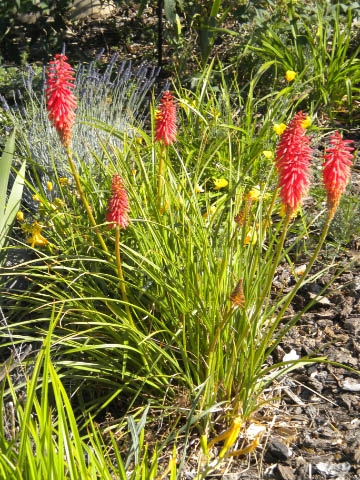
Kniphofia 'Wol's Red Seedling'. (photos by Karen Metz)
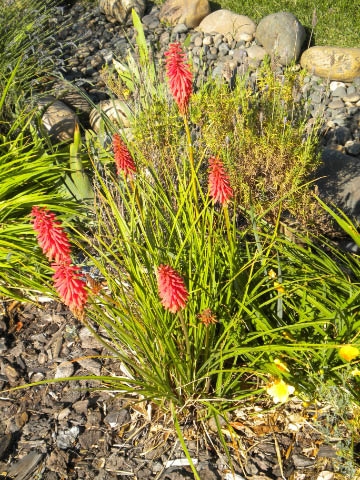
DSCN2663
Mighty Tough Lion's Tail
After surveying my yard after the string of days of hard frosts, I am so impressed with my Lion's Tail, Leonotis leonurus. Many of my other plants have crumpled, but this plant stands stately and tall and is still in bloom. I had it in a pot for years, but put it in the ground about a year and a half ago.
It grows in Sunset zones 8-24, takes full sun and little water. It is a member of the mint family and originally from South Africa. It starts blooming in the summer and is still going. The blooms are extremely long lasting and feel almost fuzzy. The flowers make an exciting addition to floral arrangements. The flowers dry beautifully as well.
Sunset says it can freeze if it gets cold enough, but if that happens to just cut it back in the spring. Leonotis can grow four to six feet tall and has toothed leaves that range from two to five inches long. My plant is only about three feet tall now, but then I pick the flowers often.
UC Davis team combats malnutrition
UC Davis nutrition researchers invented a four-teaspoon snack that can be used to supplement children's diets in poor countries to ensure proper body and brain development, according to a story in the Sacramento Bee.
Each ketchup-packet-sized serving of "Nutributter" contains 120 calories and 40 essential vitamins and minerals.
The idea for the nutrition supplement came from the successful use of Plumpy'nut, a peanut-based food developed by French researchers for famine relief. Each Plumpy-nut packet has 500 calories and children can gain 1 to 2 pounds a week by eating it twice daily. According to the Bee, Plumpy'nut saved some 30,000 lives in the Darfur region of Sudan in 2004.
Unlike Plumpy-nut, Nutributter is not meant as a sole food source. Parents mix the paste into food they feed their children.
"Many households simply don't have access to highly nutritious foods," the story quoted UC Davis nutrition professor Kathryn Dewey. "Because infants don't need a lot of calories, we've designed a supplement that is low in calories but has all the essential nutrients."
The UC Davis team leads the International Lipid-based Nutrient Supplements Project, a collaboration that is testing Nutributter in three African countries. Last year, the project won a $16 million Bill and Melinda Gates Foundation grant.
A 2008 UC Davis news release announcing the Gates Foundation grant gives more details about Nutributter and its use in African nations.

Kathryn Dewey (center with maroon shirt) with collaborators in Africa.


